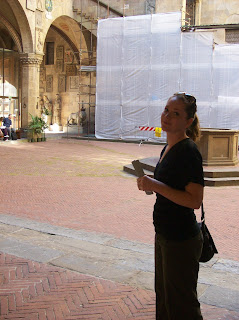
I had been to the Piazza di San Marco many times but I had never been inside the San Marco church on its north side. Nor had I been to the friary turned museum attached to it. Actually, I still haven't been in the church because we went on a Sunday and mass was in progress. I had been to the piazza mainly because it is a major bus hub and I often catch my number 10 bus to I Tatti from the south side of the piazza. Anyway, we went to the museum next to the church seen above.

The church and grounds on this site have changed hands over the years, but it is most remembered now for the time when it was a Dominican friary.

There are frescoes all over the inside and outside. There are many works by Fra Angelico and Fra Bartolomeo, among others.

I think this Crucifixion was by Fra Angelico. It shows St. Dominic at the base of the cross. Fra Angelico was an early Renaissance painter from the hills just north of town in Fiesole. Angelico means the angelic one. He lived from 1395-1455. He was beatified by Pope John Paul II.

Here is one of the more famous versions of Sarah's gesture. We found three examples of it at San Marco. This one was also by Fra Angelico.

Sarah does her best impersonation of a friar. Or a librarian. I'm not sure.

This Crucifixion is also by Fra Angelico and it shows the crosses surrounded by saints.

Sarah examines the authenticity of the work. We often joke that Sarah and her group should make fake badges or something and march into museums and to the front of lines saying, "Art historians coming through." It might work.

Here are a bunch of images of saints.

This one of St. Dominic (and many of the others) was by Fra Bartolomeo.

Here is perhaps the most famous one-time resident of the Dominican friary at San Marco. Girolamo Savonarola was a Dominican friar who lived from 1452 to 1498 when he was executed. After the Medici were overthrown in 1494, Savonarola became the secular and religious leader of Florence. He liked to burn books. This was painted by Fra Bartolomeo.

Here is my last shot before I was told that I was not allowed to take pictures inside the museum. So here are some images I found on the Internet of things I wasn't allowed to take pictures of:

Here is an image of the Last Supper by Domenico Ghirlandaio.

I got yelled at for trying to take a picture of this one. It is The Annunciation by Fra Angelico. I had a clear shot to take the picture but a guard walked around the corner just as I put the camera in front of my face. I played dumb. It wasn'thard.

So I continued to take a few pictures. One of the really neet things about the museum is that the second floor has all of the novices' cells open and you can go all the way inside some of them. Each cell had a fresco on the wall to help the friars pray or concentrate or something. Ask Sarah.
You can see inside Savonarola's larger cell also.
On the way out we saw one last version of Sarah's gesture, but there was a guard sitting very nearby. I tried to create a diversion and to stand between them so that Sarah could take a picture but she was on to us. She watched Sarah like a hawk. Which is what you have to do with Sarah. You can't trust her. She's shifty.













































